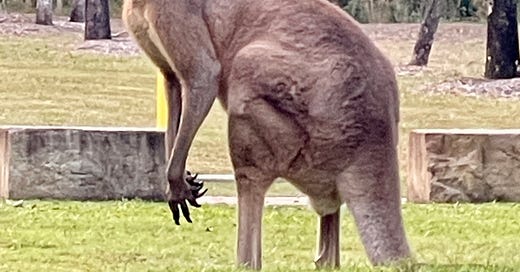You’re working from your laptop in a local university library when you decide to take a walk outside.
You exit through a set of sliding doors, and the brisk autumn wind delivers a scent of damp to your nose. You’re descending a set of stairs, enjoying the sight of the old-growth magnolia trees and feeling quite collegiate in your sweater and jeans.
You step down onto the cobbled brick surface of the outdoor plaza, and then stop dead in your tracks.
Not ten yards ahead of you, in a patch of grass beneath the shade of a tree, stands one of the strangest creatures you’ve ever seen. It’s staring right at you, standing nearly at eye-level with its oddly human arms and hands hanging limp at its sides. Its snout is almost like a dog’s… or is it more like a deer’s? In any case, from the waist-down it appears to have the body of a giant rabbit. Feet twice the length of your own stick straight out in front of it, perfectly parallel to each other.
As you stare at this thing, you notice movement in its strangely bloated belly. And then, to your surprise, out of the belly pops the face of a smaller creature, which looks at you curiously and then disappears back into the larger one’s stomach.
Then, as you watch, this Russian nesting doll of mammalian strangeness bends over and starts hopping away. Before long, the kangaroo has passed through two university buildings and out of sight.
And suddenly you’re left standing in that cobbled brick plaza with a new view of your surroundings. You glance up at the magnolia trees and realize that rising up amongst them is a tropical-style palm you hadn’t noticed before. And the birds darting between the branches aren’t robins or cardinals, but rainbow-striped parrots and enormous white cockatoos. And then you notice the sounds of a distant ACK-ACK-ACK-ACK-ACK-ACK-ACK-ACK-ACK sound that’s somewhere between SpongeBob SquarePants giggle and a machine gun.
And now that you think of it, even the air feels different. There’s a scent that’s unfamiliar, a moist there-ness to it that calls your attention.
This is the experience I’ve had regularly since moving from the western United States to Australia’s Sunshine Coast two years ago. The slow acclimation, the forgetting my own foreign-ness, and then a sudden something (like a kangaroo) that starkly reminds me that I’m far from home.
But those experiences have been getting less frequent, less stark. Soon, probably sooner than I even expected, this will be the familiar place. And all those strange, esoteric features of where I am — the kangaroos, the parrots, the palm trees — will become the familiar hallmarks of home. This home. And when I visit the U.S., the towering peaks of the Rockies will shock me.
That will be nice, and also a little sad.
My research project at the university where I teach and study is focused on creativity, and how we can influence the environments which influence our creative work. That means I’ve been reading a lot about the factors that empower us to be more creative, and the ones that put up barriers to new ideas.
One thing that comes up again and again is the power of learning and exploring outside of your “domain,” or the field in which you do your creative work. If you’re a painter, visual art is your domain. If you’re a fiction writer, it’s fiction.
One irony of the academic world that I’ve discovered is that on one hand you’re constantly encouraged to specialize, to narrow your focus, to hone in on the one very specific niche that no one else has explored. And yet on the other hand, you’re reminded again and again that the great thinkers across history, the ones who didn’t just add to their field but transformed it, are the ones who learned broadly, read widely, and connected seemingly unconnected ideas.
Why does that stuff matter? Why did playing the violin help Einstein crack special relativity?
It’s because our minds work through analogies. Something new in one mental landscape helps us see something new in another. We watch the ocean coming in and out, in and out, and it reminds us that life’s rhythms are the same — what comes must go, and then come back again. We say “tomorrow’s a new day” when something bad happens even though “days” are a fact of astronomy, not humanity. Your life isn’t going to be better tomorrow just because the calendar has a different number on it. But the power of our emotional minds is such that a new day is enough to make our lives perceptually new.
A kangaroo in a field casts everything around it in a new light. And that newness makes me more mindful, and that mindfulness makes me feel happier.
I guess the point I’m making is this: do stuff that won’t do anything for your career. That won’t advance your knowledge in a field that’s relevant to your work. Read books that aren’t relevant to you. Talk to people who are nothing like you, that definitely aren’t going to make it into your friend group.
Those new experiences are introducing analogies into your life, analogies that might just help you understand yourself — or the world — a little better, and bring you a little more joy along the way.






Really enjoyed this, and it’s so true!